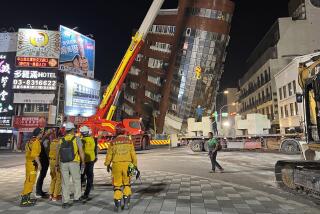Japan quake preparedness no match for 8.9
Earthquakes dwell deep in the Japanese imagination.
No country may be better prepared for a major earthquake than Japan. Seismic standards for construction are among the strictest in the world. From a young age, Japanese learn to dive under desks to protect themselves in a quake. The nation has a state-of-the-art tsunami warning system.
That preparation undoubtedly saved many lives Friday, when a magnitude 8.9 earthquake struck off Japan’s main island, shaking buildings in a large swath of the country and sending a 30-foot tsunami onto a populated stretch of coast.
Photos: Scenes from the earthquake
But an uncomfortable truth may emerge from this quake, which killed hundreds of people and caused damage that could mount into the hundreds of billions of dollars. The lesson is that there’s only so much that disaster preparedness can do. At some point, humans — even those in an affluent society with 21st century technology and peerless infrastructure — respond to deeper need to panic or flee.
The scenes from Japan captured the almost incomprehensible power of one of the strongest earthquakes ever recorded. The tsunami swept away houses, cars and ships like so much debris in a storm channel. Roads split apart; buildings buckled. And faces registered the shock and bewilderment of people whose disaster training vaporized in the violence of the moment.
“The people in my office were frozen,” said Shinji Tanaka, who works at an information technology company in Tokyo. “Nobody had any idea what to do.”
Every year, Japan observes Disaster Prevention Day to commemorate the Great Kanto Earthquake of 1923, which killed more than 100,000 people in and around Tokyo. That disaster, along with the 1995 quake in Kobe, which killed more than 6,000 people, are as drilled into Japanese memory as World War II , and discussed far more openly.
In August, the annual drill was built around a scenario in which a major earthquake kills 25,000 people and destroys 550,000 buildings, an assessment based on a 2003 projection by the Central Disaster Prevention Council.
“For every Japanese, there’s the fear of the big one,” said Yasunori Ando, 27, a magazine editor who was visiting India when this week’s quake struck Japan. “The Hanshin [Kobe] earthquake wasn’t in such a populous area, but the big concern is it will occur in Tokyo or Nagoya. You live with a constant fear. Nobody knows if it will come tomorrow, in a year, 10 years or 100 years, but many Japanese know it will come.”
The preparations have become part of the culture. Most schools and offices keep helmets handy, as well as first aid kits. Disaster training begins early and can include sessions in earthquake simulators that mimic the effect of a major quake on a building.
Disaster supplies such as reflector blankets, collapsible water containers and hand-cranked cellphones are easily found in convenience and department stores. Neighborhoods are organized with water storage facilities. Parks, shrines and temples are designated as congregation points in case of disaster.
Not all of that preparation came into play Friday. It appears that the tsunami hit too quickly for any warning system to help. Although some people could be seen wearing helmets, most lacked the time or presence of mind to put them on.
And in a country where minor earthquakes occur daily, some people didn’t initially recognize the gravity of the situation.
Others did precisely what they had been taught not to do. Videos captured terrified people bolting out of buildings while heavy debris was crashing onto streets and sidewalks. A woman in a grocery store tried to steady a shelving unit that threatened to collapse on her. Office workers stood in place, dumbstruck.
In other ways, the foresight paid off. High-rise buildings could be seen swaying like trees in a strong wind, the intended result of engineering that allowed them to flex in a quake. Tanaka, the IT worker, said that though people initially froze in his office, they soon were jolted into action.
“I got under the desk,” he said. “We followed the orders of the person who had been appointed for this sort of thing. We do drills about once a year.”
Chieko Yoshida, 26, was in her sixth-floor office in Tokyo when the quake hit at 2:46 p.m.
“We thought it would stop but it didn’t,” she said. “We all realized that this was different. I turned on the TV on my cellphone and saw that the epicenter was close to Iwate and other areas up north. That’s when we heard the security and maintenance staff tell us not to go outside because it was dangerous. Apparently that’s common sense. We didn’t know, though, because this is the first time we’ve had such a big earthquake.
“When it hit,” she added, “it passed through my mind that this could be the big one. What can you do? There’s nothing you can do about it. It’s an act of nature. There will be more.”
Photos: Scenes from the earthquake
mitchell.landsberg@latimes.com
Special correspondent Hall reported from Tokyo and Times staff writer Landsberg from Los Angeles. Times staff writer Mark Magnier in New Delhi contributed to this report.
More to Read
Start your day right
Sign up for Essential California for news, features and recommendations from the L.A. Times and beyond in your inbox six days a week.
You may occasionally receive promotional content from the Los Angeles Times.






